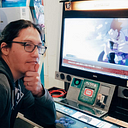SFV Nash in one week: Newbie tips and resources
by Patrick Miller — follow me on Twitter, Twitch, YouTube, or subscribe to my newsletter! Also, you might like my short stories Re: Member and MVP — a game dev short story.
Wrapped up one week of playing Nash last night, and as it happens, that week was in-between two Infiltration tournament victories (Final Round and NorCal Regionals)! Read on to find out how I got started, tips for new Nash players, and some thoughts on what I learned from playing Nash for a week.

Nash beginning resources
First off, I recommend checking out Bafael’s Nash stuff for a good starting point on his toolset. Once you’re a little more familiar with what he can do, watch this Infiltration compilation from Final Round, and don’t forget to check out my Nash replay review video:
Getting started with Nash
It took me a few days to get used to Nash’s toolset, and with good reason: He’s incredibly versatile. Watch Infiltration’s matches and you’ll notice that he can spend most of the round running away, harassing the opponent with Sonic Booms and pokes, and once his opponent tries to close the gap he’ll dash in with a poke or a throw to reset the momentum. If he gets cornered, he’s one V-Reversal or V-Trigger away from swapping positions and putting his opponent in the corner.
He’s also got an effective set of basic tools: crouching MP and EX Sonic Scythe as his main anti-airs, easy combos into LK Sonic Scythe after a crouching LK and a standing LP (which also combos into his super), good mid-range pokes with his f+MK, MK Sonic Scythe, and crouching MK, and even good long-range pokes in f+HK, f+HP, and his Sonic Booms. Plus, his f+MP overhead is a great way to close out a roud.
In fact, one of the best ways to understand Nash’s strengths is to read Daigo’s anti-Nash strategy post (translated by Jiyuna, thanks buddy!) to understand all the stuff Nash can shut down. The fact that he has excellent anti-fireball tools in both his V-Trigger and his super alone let him control a lot of momentum in a match.
If anything, the challenge for new Nash players is going to be getting used to the fact that Nash can fight wherever he wants, meaning it’s up to the Nash player to identify where he wants to be in any given matchup, and how to get there. If Nash wants to get in, he can do it by simply chucking a Sonic Boom and following up with a Moonsault Kick, or a dash, or a V-Trigger; or, he can run away and bait the opponent into dashing in and punishing, giving him the same end result. The latter is probably more destructive to the opponent’s morale, since they put in the work of chasing you and ended up on the defensive.
That said, Nash’s tools aren’t as simple and straightforward as, say, Ryu’s. Nash’s f+LK and f+HP are pretty situational, and it takes a while to learn the rhythm and spacing for Nash’s anti-airs compared to other characters. Also, his up-close options aren’t quite as scary as the rest of the characters we’re seeing do well in tournaments (R. Mika, Ryu, Necalli, Karin, or Cammy) so once you run out of fairly basic frame traps and throws you’ll probably find yourself doing more of your damage at mid-range.
What I learned about SFV from playing Nash
In the first week or so of SFV’s release, I thought it felt kind of like a worse version of Tekken — mostly because a lot of the action happens very quickly in more or less the same in-close range — and so I tried to play F.A.N.G. and Ryu to see if there was a way to get more action happening further away. I actually don’t think those two characters are particularly good at range, but Nash sure is, albeit for kind of silly reasons; he can close the gap very easily, engage whenever he wants, and then go back to running away at minimal risk or cost to himself. It’s an interesting hit-and-run style of play that I haven’t seen much of outside of like, Chipp in Guilty Gear.
I think that Nash probably has the most versatile toolset out of everyone in the game, and as a result it means that you’re largely stuck playing the game he wants to play and trying to beat him at it so you can play your game. That doesn’t necessarily mean he’s super good or anything, but it does mean he has a pretty powerful edge over characters that need to be in a certain range or space in order to succeed. This is especially useful for when you’re playing lots of new opponents (climbing out of pools in a tournament or playing ranked games, for example) because you get to force them to play your game instead of trying to learn how to pick apart theirs, so barring some major new innovations in anti-Nash tech, I’d recommend him as a good character to grow into.
Off the top of my head, the hardest matchups I ran into were Karin and Bison; think this is mostly because I had a hard time dealing with their approaches (especially Bison’s dang headstomp) and once they’re in I have to work hard or eat hits to get them off me.
Next up: In honor of Marn’s amazing run at NCR last weekend, I’ll be playing R. Mika! (I’m still behind on my Cammy Week writeup, too…)
